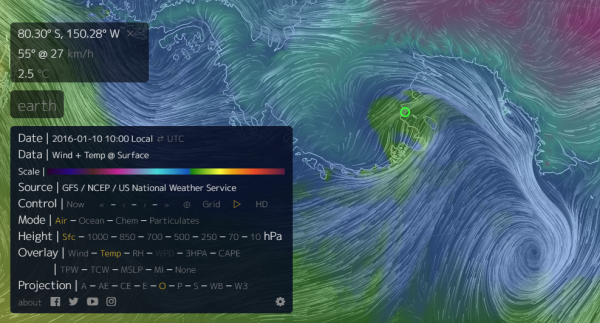Raining in the Antarctic
The Rains of Antarctica are Coming — Warm Summer Storms Melted Texas-Sized Section of Ross Ice Shelf Surface During 2016
“In
West Antarctica, we have a tug-of-war going on between the influence
of El Niños and the westerly winds, and it looks like the El Niños
are winning. It’s a pattern that is emerging. And
because we expect stronger, more frequent El Niños in the future
with a warming climate, we can expect more major surface melt events
in West Antarctica (emphasis
added).”
— David
Bromwhich,
co-author of a recent
study identifying
massive summer surface melt in West Antarctica during 2016.
******
15
June, 2017
If
you’re concerned about human-caused global warming, then you should
also be concerned about ice. In particular — how warming might melt
a miles-high pile of the frozen stuff covering the massive continent
of Antarctica.
During
recent years, scientists have become more and more worried as they’ve
observed warming oceans eating away at the undersides of floating ice
sheets. This particular process threatens numerous cities and coastal
regions with swiftening sea level rise as ice margins melt and
glaciers the size of mountain ranges clamor for release into the
world’s oceans.
Major
Antarctic Surface Melt Event During 2016
But
another potential process in a still warmer world threatens to
compound the impact of the heating waters that are already melting so
many of the world’s glaciers from the bottom up — large scale
surface melt.
(A
major warming event during January of 2016 turned a Texas-sized
section of Antarctica’s surface into slush. This occurred as a
storm running in from the Southern Ocean delivered warm air and
rainfall to sections of West Antarctica. Scientists are concerned
that more major surface melt is on the way for Antarctica as the
Earth’s climate heats up and that repeated warming and rainfall
events in this typically-frozen region may further quicken rates of
sea level rise. Image source: Earth
Nullschool.)
During
January of 2016, as a very strong El Nino was combining with
human-caused global warming to spike atmospheric temperatures to 1.2
C above 1880s levels, something
pretty strange and concerning happened.
Over the course of about 15 days, a 300,000 square mile section of
the Ross
Ice Shelf surface
and nearby lands over West Antarctica experienced melting. This
mass slushing across Antarctica’s surface occurred
as a warm storm swept in from the Southern Ocean (see image above) to
deliver an unheard of rainfall event to the region.
West
Antarctica is typically too cold for such weather. It is also often
too dry. The
region is well know by climate researchers as a frozen desert.
But as human-forced climate change has warmed the nearby ocean, warm,
moist winds blowing in from these heating waters have become more
frequent.
Westerlies
Interrupted by Warming Ocean
Antarctica
is typically protected by strong westerly winds that keep both heat
and moisture out. But a warming ocean environment, according
to Ohio State researchers,
is enabling El Nino to interrupt these westerlies and hurl increasing
volumes of heat and moisture over the glaciers of Antarctica. In
2016, these winds bore with them an odd rainstorm that set off a
massive surface melt event.
(Surface
melt over a large section of West Antarctica lasted for as much as 15
days as heat and moisture from the surrounding ocean beat back a
protective barrier of westerly winds and invaded the frozen
continent. According to scientists, these events are likely to become
more frequent and long-lasting as the climate warms. Image
source: Ohio
State University.)
When
combined with already-active melt from ocean warming, surface melt
could further serve to destabilize ice sheets and swiften sea level
rise. This was exactly the concern that David Bromwich, an Antarctic
researcher at Ohio State and co-author of the paper that identified
this strange event highlighted in this statement (please
see related Washington Post article here):
“It provides us with a possible glimpse of the future. You probably have read these analyses of West Antarctica, many people think it’s slowly disintegrating right now, and it’s mostly thought to be from the warm water eating away at the bottom of critical ice shelves. Well, that’s today. In the future, we could see action at the surface of these ice shelves as well from surface melting. So that makes them potentially much more unstable (emphasis added).”
It’s
worth noting that this particular storm, though unusual and
noteworthy, did not produce too much in the way of surface melt
ponding. Instead,
the storm turned a large section of the Antarctic surface to a
slurpee-like slush.
But this event did deliver a considerable amount of heat to the Ross
Ice Shelf region. And repeated instances could serve to seriously
soften this massive ice formation.
Eventually,
as warming worsens, significant surface melt and flooding could help
to shatter large buttressing ice shelves like Ross or even generate
risks of surface glacial outburst flooding in instances where
permanent surface melt lakes form behind an ice dam. But the primary
concern at this time is that these warm rain events provide a
compounding melt influence that adds to risks for more rapid sea
level rise this Century.
Links:
Hat
tip to TodaysGuestIs





No comments:
Post a Comment
Note: only a member of this blog may post a comment.